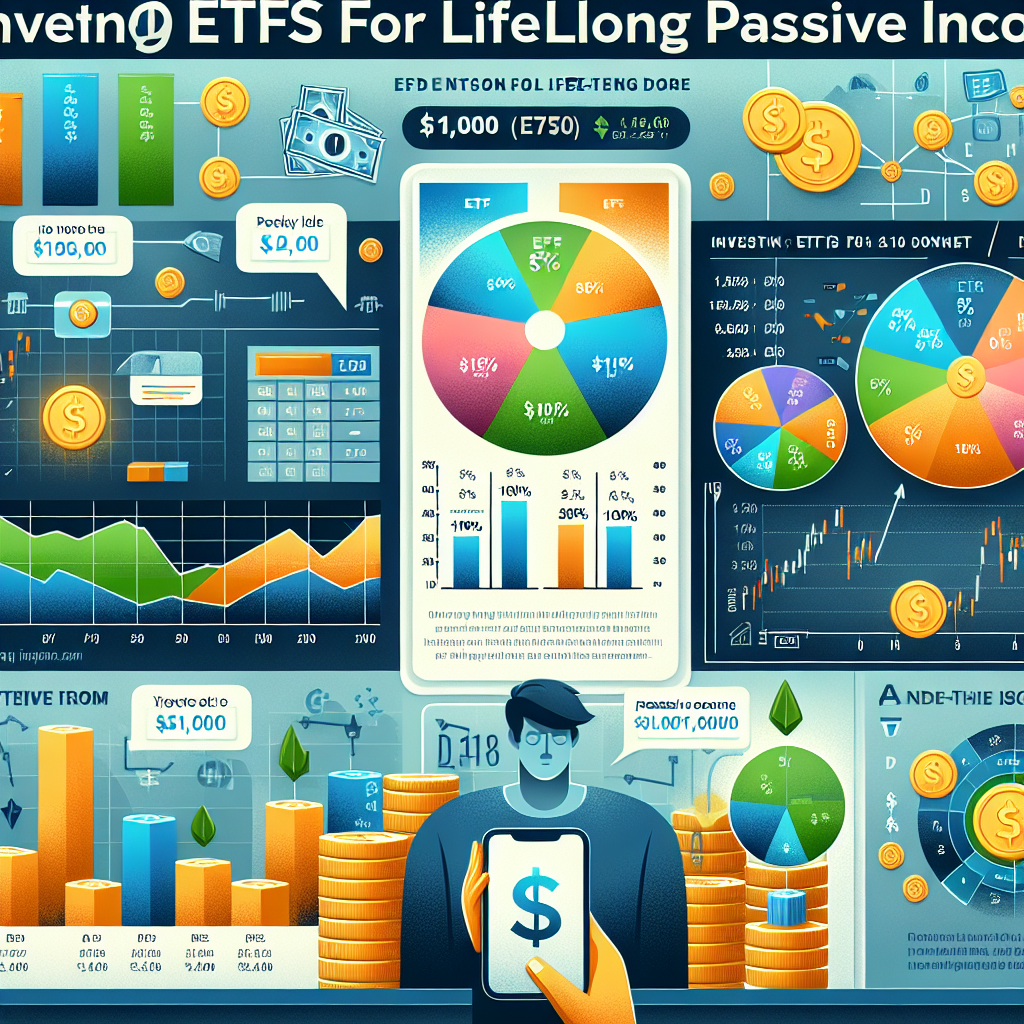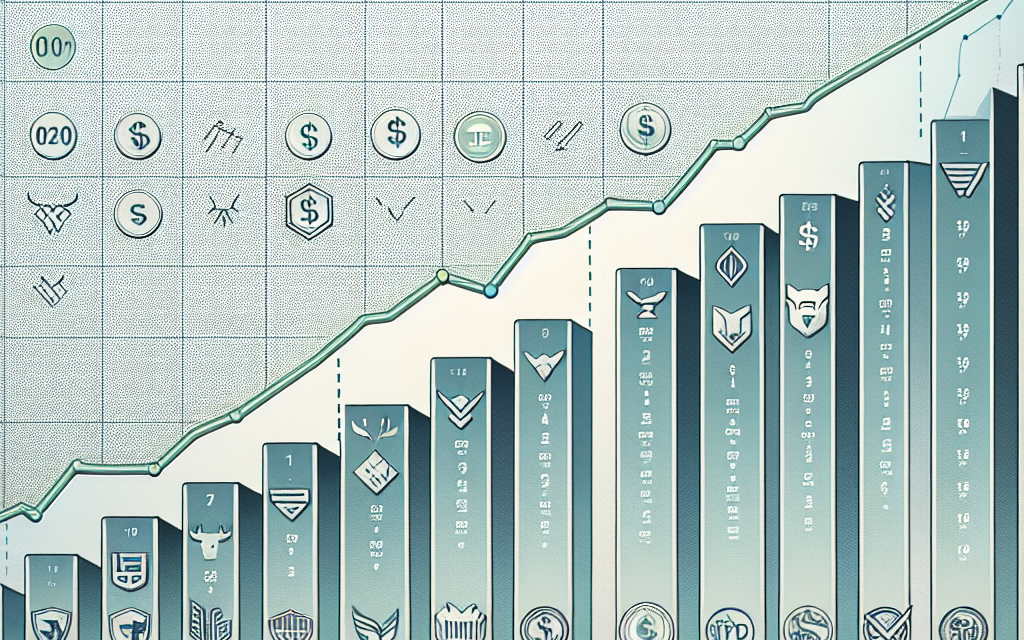“Secure Your Future: Top 10 Dividend ETFs for Lifelong Passive Income with Just $1,000”
Introduction
Investing in dividend-focused exchange-traded funds (ETFs) can be a strategic way to generate lifelong passive income. These ETFs pool together a diversified portfolio of dividend-paying stocks, offering investors exposure to a wide range of companies that regularly distribute a portion of their earnings back to shareholders. For those looking to invest $1,000 with the goal of building a steady income stream, selecting the right dividend ETFs is crucial. The top 10 dividend ETFs to consider are known for their strong track records, consistent dividend payouts, and potential for capital appreciation. These funds typically focus on high-quality, established companies with a history of reliable dividend payments, making them an attractive option for investors seeking both income and growth. By investing in these top-performing dividend ETFs, individuals can benefit from the power of compounding dividends over time, ultimately achieving financial stability and passive income for the long term.
Understanding Dividend ETFs: A Beginner’s Guide
Investing in dividend exchange-traded funds (ETFs) can be an excellent strategy for those seeking to generate lifelong passive income. These financial instruments pool together a collection of dividend-paying stocks, offering investors a diversified portfolio that can yield regular income. Understanding the fundamentals of dividend ETFs is crucial for beginners who wish to make informed investment decisions. By exploring the characteristics and benefits of these funds, investors can better appreciate why they are a popular choice for income-focused portfolios.
Dividend ETFs are designed to track indices composed of companies known for paying consistent and, often, increasing dividends. This focus on dividend-paying stocks provides investors with a steady income stream, which can be particularly appealing in volatile market conditions. Moreover, the diversification inherent in ETFs helps mitigate the risks associated with investing in individual stocks. By spreading investments across various sectors and companies, dividend ETFs reduce the impact of any single company’s poor performance on the overall portfolio.
One of the primary advantages of dividend ETFs is their ability to offer a relatively high yield compared to traditional savings accounts or bonds. This higher yield is particularly attractive in low-interest-rate environments, where traditional fixed-income investments may not provide sufficient returns. Additionally, dividend ETFs often include companies with a history of increasing their dividend payouts, which can lead to growing income over time. This potential for income growth makes dividend ETFs an appealing option for long-term investors seeking to build wealth through compounding returns.
Furthermore, dividend ETFs offer a level of convenience and simplicity that is appealing to both novice and experienced investors. Unlike individual stock selection, which requires extensive research and analysis, investing in a dividend ETF allows investors to gain exposure to a broad range of dividend-paying companies with a single transaction. This ease of access is complemented by the liquidity of ETFs, which can be bought and sold on major stock exchanges just like individual stocks. This liquidity ensures that investors can enter or exit positions with relative ease, providing flexibility in managing their investment portfolios.
In addition to these benefits, dividend ETFs often come with lower expense ratios compared to actively managed mutual funds. This cost efficiency is due to the passive management style of most ETFs, which aim to replicate the performance of a specific index rather than outperform it. Lower expenses mean that a larger portion of the investor’s returns is retained, enhancing the overall profitability of the investment.
However, it is important for investors to be aware of the potential risks associated with dividend ETFs. While diversification reduces company-specific risk, it does not eliminate market risk. Economic downturns or changes in interest rates can impact the performance of dividend-paying stocks and, consequently, the ETFs that hold them. Therefore, investors should consider their risk tolerance and investment goals when selecting dividend ETFs.
In conclusion, dividend ETFs represent a compelling option for investors seeking to generate passive income over the long term. By offering diversification, higher yields, and convenience, these funds can play a vital role in a well-rounded investment strategy. As with any investment, it is essential for individuals to conduct thorough research and consider their financial objectives before committing capital. By doing so, investors can harness the potential of dividend ETFs to achieve their income goals and build a sustainable financial future.
Top 10 Dividend ETFs for Consistent Passive Income
Investing in dividend exchange-traded funds (ETFs) can be a strategic approach for those seeking to generate lifelong passive income. These financial instruments pool together a collection of dividend-paying stocks, offering investors a diversified portfolio that can yield consistent returns. With a modest investment of $1,000, individuals can tap into the potential of dividend ETFs to secure a steady income stream. As we explore the top 10 dividend ETFs, it is essential to consider factors such as yield, expense ratio, and historical performance to make informed decisions.
To begin with, the Vanguard Dividend Appreciation ETF (VIG) is a popular choice among investors. This ETF focuses on companies with a history of increasing dividends over time, providing a reliable income source. Its low expense ratio and strong track record make it an attractive option for long-term investors. Similarly, the Schwab U.S. Dividend Equity ETF (SCHD) offers a competitive yield and low fees, making it a cost-effective choice for those seeking dividend income.
Transitioning to another noteworthy option, the iShares Select Dividend ETF (DVY) targets high-yielding U.S. stocks, providing investors with exposure to companies that consistently pay dividends. This ETF is particularly appealing for those looking to maximize their income potential. In contrast, the SPDR S&P Dividend ETF (SDY) focuses on companies that have consistently increased their dividends for at least 20 consecutive years, offering a blend of stability and growth potential.
Moreover, the Invesco S&P 500 High Dividend Low Volatility ETF (SPHD) combines high dividend yields with low volatility, making it an ideal choice for risk-averse investors. This ETF aims to provide a balance between income and stability, appealing to those who prioritize capital preservation. On the other hand, the WisdomTree U.S. Quality Dividend Growth Fund (DGRW) emphasizes companies with strong earnings growth potential, offering a unique approach to dividend investing.
Furthermore, the ProShares S&P 500 Dividend Aristocrats ETF (NOBL) is renowned for its focus on companies that have increased their dividends for at least 25 consecutive years. This ETF provides exposure to high-quality, established companies, making it a reliable choice for long-term investors. Additionally, the iShares Core High Dividend ETF (HDV) targets high-quality U.S. companies with strong financial health, offering a blend of income and stability.
As we continue to explore options, the First Trust Value Line Dividend Index Fund (FVD) stands out for its focus on companies with strong dividend yields and favorable valuations. This ETF provides a diversified approach to dividend investing, appealing to those seeking both income and growth potential. Lastly, the Global X SuperDividend ETF (SDIV) offers exposure to high-yielding global stocks, providing investors with an opportunity to diversify their income sources across international markets.
In conclusion, investing in dividend ETFs can be a prudent strategy for generating lifelong passive income. By carefully selecting from the top 10 dividend ETFs, investors can build a diversified portfolio that aligns with their financial goals and risk tolerance. Whether prioritizing yield, stability, or growth potential, these ETFs offer a range of options to suit various investment preferences. With a thoughtful approach and a modest investment of $1,000, individuals can embark on a journey toward consistent passive income, securing their financial future.
How to Choose the Best Dividend ETFs for Your Portfolio
When considering the best dividend ETFs for your portfolio, it is essential to understand the factors that contribute to their potential for generating lifelong passive income. Dividend ETFs, or exchange-traded funds, are investment vehicles that pool together a collection of dividend-paying stocks. These funds offer investors the opportunity to earn regular income through dividends while also benefiting from the diversification and professional management that ETFs provide. To choose the best dividend ETFs for your portfolio, several key considerations should be taken into account.
First and foremost, it is crucial to evaluate the dividend yield of the ETF. The dividend yield is a measure of the income generated by the fund relative to its price. A higher yield indicates a greater potential for income, but it is important to balance this with the risk associated with the underlying assets. While a high yield may be attractive, it could also signal that the fund is investing in riskier stocks, which may not be suitable for all investors. Therefore, it is advisable to assess the sustainability of the dividend payments by examining the fund’s historical performance and the financial health of the companies it holds.
In addition to yield, the expense ratio of the ETF is another critical factor to consider. The expense ratio represents the annual fees charged by the fund manager, expressed as a percentage of the fund’s assets. Lower expense ratios are generally more favorable, as they allow investors to retain a larger portion of their returns. When comparing dividend ETFs, it is beneficial to look for funds with competitive expense ratios, as these can significantly impact long-term returns.
Furthermore, diversification is a key advantage of investing in dividend ETFs. By holding a broad range of dividend-paying stocks, these funds can mitigate the risk associated with individual stock performance. When selecting a dividend ETF, it is important to examine the fund’s holdings to ensure that it provides adequate diversification across sectors and industries. A well-diversified ETF can help protect your portfolio from market volatility and economic downturns, thereby enhancing the stability of your passive income stream.
Another important consideration is the ETF’s track record and management team. A fund with a strong performance history and experienced management can provide confidence in its ability to deliver consistent returns. Researching the fund’s past performance, as well as the reputation and expertise of its management team, can offer valuable insights into its potential for generating lifelong passive income.
Additionally, it is worth considering the tax implications of investing in dividend ETFs. Depending on your location and tax situation, dividends may be subject to different tax rates. Some ETFs are structured to be more tax-efficient, which can enhance your after-tax returns. Consulting with a financial advisor or tax professional can help you understand the tax implications of your investment choices and optimize your portfolio accordingly.
In conclusion, selecting the best dividend ETFs for your portfolio involves a careful analysis of several factors, including dividend yield, expense ratio, diversification, track record, and tax efficiency. By taking these considerations into account, you can make informed decisions that align with your financial goals and risk tolerance. Ultimately, investing in well-chosen dividend ETFs can provide a reliable source of passive income, contributing to your financial security and peace of mind over the long term.
The Benefits of Investing in Dividend ETFs for Long-Term Growth

Investing in dividend exchange-traded funds (ETFs) offers a compelling strategy for those seeking long-term growth and a steady stream of passive income. These financial instruments pool together a diversified portfolio of dividend-paying stocks, providing investors with exposure to a wide array of companies that consistently distribute profits to shareholders. One of the primary benefits of investing in dividend ETFs is the potential for compounding returns. As dividends are reinvested, they can purchase additional shares, which in turn generate more dividends, creating a snowball effect that can significantly enhance the value of an investment over time.
Moreover, dividend ETFs offer a level of diversification that can mitigate risk. By investing in a broad spectrum of companies across various sectors, these funds reduce the impact of poor performance by any single stock. This diversification is particularly advantageous in volatile markets, where individual stock prices can fluctuate dramatically. Additionally, dividend ETFs are managed by professional fund managers who have the expertise to select and balance the portfolio, ensuring that it aligns with the fund’s objectives and risk tolerance.
Another significant advantage of dividend ETFs is their ability to provide a reliable income stream. Unlike growth stocks, which may reinvest profits back into the company, dividend-paying stocks distribute a portion of their earnings to shareholders. This makes dividend ETFs an attractive option for retirees or those seeking to supplement their income without selling off their investments. The regular income generated by these funds can be particularly beneficial during economic downturns when other sources of income may be less reliable.
Furthermore, dividend ETFs often include companies with a history of stable and increasing dividend payments. These companies, often referred to as “dividend aristocrats,” have demonstrated resilience and financial strength, making them a safer bet for long-term investors. The inclusion of such companies in a dividend ETF can provide a level of assurance that the fund will continue to generate income even in challenging economic conditions.
In addition to income generation, dividend ETFs can also offer tax advantages. In many jurisdictions, qualified dividends are taxed at a lower rate than ordinary income, which can enhance the after-tax return on investment. This tax efficiency, combined with the potential for capital appreciation, makes dividend ETFs a compelling choice for investors looking to maximize their returns.
Moreover, the liquidity of ETFs is another appealing feature. Unlike mutual funds, which are priced at the end of the trading day, ETFs can be bought and sold throughout the trading day at market prices. This flexibility allows investors to react quickly to market changes and manage their portfolios more effectively.
In conclusion, investing in dividend ETFs can be a prudent strategy for those seeking long-term growth and passive income. The combination of compounding returns, diversification, reliable income, and potential tax advantages makes these funds an attractive option for a wide range of investors. By allocating $1,000 into top-performing dividend ETFs, investors can lay the foundation for a lifelong stream of passive income, while also benefiting from the growth potential of a diversified portfolio. As with any investment, it is essential to conduct thorough research and consider one’s financial goals and risk tolerance before committing capital.
Comparing Dividend ETFs: Which One is Right for You?
When considering the best dividend ETFs to invest $1,000 for lifelong passive income, it is essential to compare various options to determine which one aligns with your financial goals and risk tolerance. Dividend ETFs, or exchange-traded funds, are investment vehicles that pool together a collection of dividend-paying stocks, offering investors a diversified portfolio with the potential for regular income. As you explore the top 10 dividend ETFs, understanding their unique characteristics and performance metrics can help you make an informed decision.
To begin with, it is crucial to evaluate the dividend yield of each ETF. The dividend yield represents the annual dividend income as a percentage of the ETF’s current share price. A higher yield may indicate a more attractive income stream, but it is important to consider the sustainability of these dividends. For instance, some ETFs may offer high yields due to the inclusion of riskier stocks, which could lead to potential volatility. Therefore, balancing yield with stability is key to ensuring a reliable income source.
In addition to yield, examining the ETF’s expense ratio is vital. The expense ratio reflects the annual fees charged by the fund, expressed as a percentage of the total assets. Lower expense ratios are generally preferable, as they minimize the erosion of returns over time. While some high-performing ETFs may justify slightly higher fees, it is essential to weigh these costs against the potential benefits.
Another factor to consider is the ETF’s diversification. A well-diversified ETF spreads its investments across various sectors and geographic regions, reducing the impact of any single economic downturn. For example, an ETF with exposure to both domestic and international markets may offer a more balanced risk profile. Additionally, sector diversification can protect against industry-specific challenges, ensuring a more stable income stream.
Furthermore, assessing the ETF’s historical performance can provide insights into its potential future returns. While past performance is not a guarantee of future results, it can indicate how the ETF has navigated different market conditions. Analyzing metrics such as total return, which includes both capital appreciation and dividends, can help gauge the ETF’s overall effectiveness in generating income and growth.
Moreover, understanding the ETF’s underlying index is crucial. Many dividend ETFs track specific indices, such as the S&P 500 Dividend Aristocrats or the Dow Jones U.S. Select Dividend Index. These indices have distinct criteria for selecting stocks, such as a history of consistent dividend payments or a focus on high-yield companies. Familiarizing yourself with these indices can clarify the ETF’s investment strategy and risk profile.
Additionally, consider the ETF’s liquidity, which refers to how easily shares can be bought or sold without significantly impacting the price. Highly liquid ETFs offer more flexibility for investors, allowing for easier entry and exit points. This is particularly important for those who may need to adjust their investment strategy in response to changing financial circumstances.
Finally, it is beneficial to review the ETF’s distribution schedule. Some ETFs pay dividends monthly, while others do so quarterly or annually. Depending on your income needs, the frequency of distributions may influence your choice.
In conclusion, selecting the right dividend ETF involves a comprehensive analysis of various factors, including yield, expense ratio, diversification, historical performance, underlying index, liquidity, and distribution schedule. By carefully considering these elements, you can identify an ETF that aligns with your investment objectives, ultimately paving the way for a reliable and lifelong passive income stream.
Maximizing Returns: Strategies for Investing $1,000 in Dividend ETFs
Investing in dividend exchange-traded funds (ETFs) is a strategic approach to generating lifelong passive income. With a modest investment of $1,000, individuals can tap into the potential of these financial instruments, which offer both diversification and regular income. As the financial landscape evolves, selecting the right dividend ETFs becomes crucial for maximizing returns. This article explores strategies for investing $1,000 in dividend ETFs, focusing on the top ten options that promise consistent income and growth potential.
To begin with, understanding the nature of dividend ETFs is essential. These funds pool money from multiple investors to purchase a diversified portfolio of dividend-paying stocks. The primary advantage of dividend ETFs is their ability to provide regular income through dividends, which are typically distributed quarterly. Moreover, they offer diversification, reducing the risk associated with investing in individual stocks. This makes them an attractive option for investors seeking stability and income.
When considering dividend ETFs, it is important to evaluate their yield, expense ratio, and historical performance. A higher yield indicates a greater income potential, but it is crucial to balance this with the fund’s expense ratio, as high fees can erode returns. Additionally, examining the historical performance of an ETF can provide insights into its reliability and growth prospects. With these factors in mind, investors can make informed decisions about where to allocate their $1,000.
Among the top dividend ETFs, the Vanguard Dividend Appreciation ETF (VIG) stands out for its focus on companies with a history of increasing dividends. This ETF offers a blend of stability and growth, making it a solid choice for long-term investors. Similarly, the Schwab U.S. Dividend Equity ETF (SCHD) is renowned for its low expense ratio and strong performance, appealing to cost-conscious investors.
Another noteworthy option is the iShares Select Dividend ETF (DVY), which targets high-yielding U.S. stocks. This ETF is ideal for those seeking immediate income, as it prioritizes companies with robust dividend payouts. In contrast, the SPDR S&P Dividend ETF (SDY) focuses on companies that have consistently increased their dividends for at least 20 years, offering a blend of reliability and growth.
For investors interested in international exposure, the Vanguard International High Dividend Yield ETF (VYMI) provides access to high-yielding stocks outside the U.S. This diversification can enhance returns and reduce risk, particularly in volatile markets. Additionally, the iShares International Select Dividend ETF (IDV) offers a similar international focus, with an emphasis on developed markets.
The Invesco S&P 500 High Dividend Low Volatility ETF (SPHD) combines high dividends with low volatility, appealing to risk-averse investors. This ETF seeks to provide stable income while minimizing market fluctuations. Meanwhile, the WisdomTree U.S. Quality Dividend Growth Fund (DGRW) targets companies with strong earnings growth potential, offering a balance of income and capital appreciation.
Lastly, the ProShares S&P 500 Dividend Aristocrats ETF (NOBL) and the First Trust Value Line Dividend Index Fund (FVD) round out the list of top dividend ETFs. NOBL focuses on companies with a long history of dividend increases, while FVD emphasizes value and stability.
In conclusion, investing $1,000 in dividend ETFs can be a prudent strategy for generating lifelong passive income. By carefully selecting funds based on yield, expense ratio, and historical performance, investors can maximize their returns while minimizing risk. The top ten dividend ETFs highlighted in this article offer a range of options to suit different investment goals and risk tolerances, providing a solid foundation for a diversified and income-generating portfolio.
The Future of Dividend ETFs: Trends and Predictions for Investors
As the financial landscape continues to evolve, dividend exchange-traded funds (ETFs) have emerged as a popular choice for investors seeking a reliable source of passive income. These investment vehicles offer a diversified portfolio of dividend-paying stocks, providing both stability and growth potential. Looking ahead, several trends and predictions are shaping the future of dividend ETFs, offering valuable insights for investors considering allocating $1,000 or more into these instruments for lifelong passive income.
One significant trend is the increasing focus on sustainability and environmental, social, and governance (ESG) criteria. Investors are becoming more conscious of the ethical implications of their investments, and dividend ETFs are no exception. As a result, fund managers are increasingly incorporating ESG factors into their selection criteria, ensuring that the companies included in these ETFs not only offer attractive dividends but also adhere to sustainable business practices. This shift is expected to continue, with more ESG-focused dividend ETFs entering the market, providing investors with options that align with their values.
Moreover, technological advancements are playing a crucial role in shaping the future of dividend ETFs. The rise of artificial intelligence and machine learning is enabling fund managers to analyze vast amounts of data more efficiently, leading to more informed investment decisions. These technologies are helping identify companies with strong dividend potential, optimizing portfolio construction, and enhancing risk management strategies. As technology continues to advance, investors can expect dividend ETFs to become more sophisticated, offering improved returns and reduced volatility.
In addition to technological advancements, demographic shifts are influencing the demand for dividend ETFs. As the global population ages, there is a growing need for income-generating investments to support retirement. Dividend ETFs, with their regular income distributions, are well-suited to meet this demand. Consequently, fund providers are likely to develop products tailored to the needs of retirees, focusing on stability and consistent income streams. This demographic trend is expected to drive further growth in the dividend ETF market, making it an attractive option for long-term investors.
Furthermore, the global economic environment is another factor impacting the future of dividend ETFs. In recent years, low interest rates have pushed investors to seek higher yields, making dividend-paying stocks more appealing. While interest rates may fluctuate, the demand for income-generating investments is likely to persist, supporting the continued popularity of dividend ETFs. Additionally, as emerging markets continue to develop, they present new opportunities for dividend growth. Investors can expect to see more dividend ETFs with exposure to these regions, offering diversification and potential for higher returns.
Lastly, regulatory changes could also influence the landscape of dividend ETFs. As governments worldwide implement policies to promote sustainable investing and protect investors, fund managers may need to adapt their strategies to comply with new regulations. This could lead to increased transparency and accountability within the industry, ultimately benefiting investors by ensuring that dividend ETFs remain a reliable source of passive income.
In conclusion, the future of dividend ETFs is shaped by a confluence of factors, including sustainability trends, technological advancements, demographic shifts, economic conditions, and regulatory changes. For investors looking to invest $1,000 or more for lifelong passive income, understanding these trends and predictions is crucial. By staying informed and adapting to the evolving landscape, investors can make well-informed decisions that align with their financial goals and values, ensuring a steady stream of income for years to come.
Q&A
1. **What is a Dividend ETF?**
A Dividend ETF is an exchange-traded fund that focuses on investing in a portfolio of dividend-paying stocks, providing investors with regular income.
2. **Why invest in Dividend ETFs for passive income?**
Dividend ETFs offer a diversified portfolio of income-generating stocks, reducing risk and providing a steady stream of income through dividends.
3. **What are some top Dividend ETFs to consider?**
Some top Dividend ETFs include Vanguard Dividend Appreciation ETF (VIG), iShares Select Dividend ETF (DVY), and Schwab U.S. Dividend Equity ETF (SCHD).
4. **What is the expense ratio, and why is it important?**
The expense ratio is the annual fee expressed as a percentage of the fund’s average assets, impacting the net return on investment. Lower ratios are generally more favorable.
5. **How does dividend yield affect ETF selection?**
Dividend yield indicates the annual dividend income relative to the ETF’s price. Higher yields can mean more income, but they may also indicate higher risk.
6. **What role does diversification play in Dividend ETFs?**
Diversification in Dividend ETFs spreads risk across various sectors and companies, reducing the impact of poor performance from any single stock.
7. **How can investing $1,000 in Dividend ETFs benefit long-term income goals?**
Investing $1,000 in Dividend ETFs can compound over time through reinvested dividends and capital appreciation, potentially leading to significant passive income in the long term.
Conclusion
Investing in dividend ETFs can be a strategic approach for generating lifelong passive income, as they offer diversification, professional management, and regular income distributions. The top 10 dividend ETFs to consider for a $1,000 investment include Vanguard Dividend Appreciation ETF (VIG), iShares Select Dividend ETF (DVY), Schwab U.S. Dividend Equity ETF (SCHD), SPDR S&P Dividend ETF (SDY), iShares Core High Dividend ETF (HDV), Vanguard High Dividend Yield ETF (VYM), ProShares S&P 500 Dividend Aristocrats ETF (NOBL), WisdomTree U.S. Quality Dividend Growth Fund (DGRW), Invesco S&P 500 High Dividend Low Volatility ETF (SPHD), and Global X SuperDividend ETF (SDIV). These ETFs are selected based on their historical performance, dividend yield, expense ratio, and the quality of the underlying holdings. By investing in a mix of these ETFs, investors can potentially achieve a balanced portfolio that provides steady income and capital appreciation over time. However, it’s crucial to conduct thorough research and consider individual financial goals and risk tolerance before making investment decisions.





